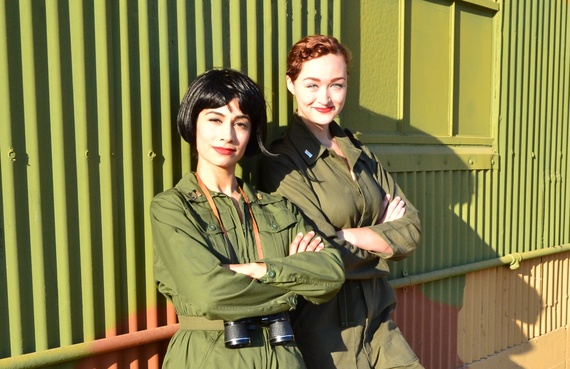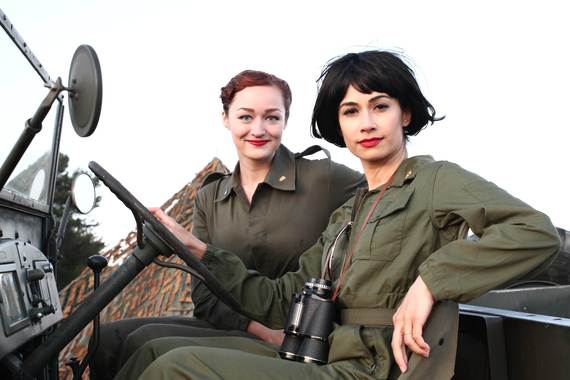[The post below was featured today at The Huffington Post.]
By Govindini Murty. Women have been the stars of many of our biggest sci-fi films recently – from Star Wars: The Force Awakens to The Hunger Games and Gravity. This has been a very welcome development – but we need more women behind the camera as creators of sci-fi, as well. We need the female equivalents of George Lucas, Steven Spielberg, and James Cameron. But how do we do this, given the many obstacles in the way of women filmmakers?
There is an entire online industry of VFX-driven sci-fi shorts that are launching male filmmakers’ careers right now. If women are to direct and produce blockbuster sci-fi films, then we must also enter this arena of online sci-fi shorts.
I’d like to introduce you to my epic, women-led sci-fi short film UFO Diary, debuting today on Vimeo. UFO Diary is a sci-fi action-comedy about two Women’s Army Corps officers in WWII who fight off an alien invasion of Los Angeles. The film recreates a famous WWII air raid, is edited by Emmy Award-winner Mitch Danton, and features stunning VFX by artists from ILM, Weta Digital, and Digital Domain. UFO Diary was recently featured in the January issue of American Cinematographer.
UFO Diary is inspired by one of the most famous UFO incidents in history – the Great Los Angeles Air Raid of 1942. We’re releasing UFO Diary today to commemorate the upcoming anniversary of the Air Raid on February 25th.
In the early hours of February 25th, 1942, a mysterious, unidentified flying object appeared in the skies over Los Angeles. The Army fired a massive barrage of 1400 shells into the night sky – but nothing was shot down, and no wreckage was ever recovered. The incident was witnessed by over 100,000 Angelenos, but remains unexplained to this day.

Making a film about the Great LA Air Raid was a colorful adventure in itself. In addition to producing UFO Diary, I also played the lead role of Captain Diana Ravello, a tough WAC captain and former Caltech rocket engineer. Playing Captain Diana involved me climbing over tanks and half-tracks, firing anti-aircraft guns in the middle of simulated WWII combat, getting my hearing blasted by machine-gun fire, and being swallowed up in massive dust clouds from tanks as I ran around a WWII-era fort. It was a great experience and I wouldn’t trade it for anything.
During all this, I also collaborated on every aspect of the film – from story concept to cinematography to editing – with my filmmaking partner, Jason Apuzzo, the writer-director of UFO Diary. Jason is my husband and one of the most supportive people I know of women in film. We were united in wanting to make a WWII movie with women in the lead roles because we both wanted to tell a WWII story from a fresh perspective.
Producing UFO Diary also meant wrangling a cast of over one hundred WWII actors – including some pretty salty military vets (who were my favorites) – and hiring and supervising everyone on the crew, VFX, and post-production teams.
I’m excited now to be sharing UFO Diary with you, in part to show that women filmmakers can make sci-fi shorts as spectacular and technically-challenging as any male filmmaker out there.
Filmmaking isn’t just about hardware and VFX, though. Also very important to Jason and me was honoring the real women who served in WWII. The lead characters in UFO Diary – Captain Diana Ravello and Lt. Margie Petrova (played by Rachel Newell) – are inspired by the real women who served in the Women’s Army Corps in WWII. The creation of the Women’s Army Corps (known initially as the Women’s Army Auxiliary Corps or WAACs, later changed to WACs) marked the first time in U.S. history that women were allowed to serve as anything other than nurses in the Army.

Over 150,000 WACs served in WWII, despite enormous opposition from many in the Army. According to an official U.S. Army history of the WACs, in addition to carrying out support functions like operating switchboards and sorting mail, WACs also flew planes, served as scientists, cryptographers, truck mechanics, radio operators, photographers, map analysts, sheet metal workers, armorers, lab technicians, and much more. WACs also worked in the Manhattan Project: they ran the cyclotron at Los Alamos, constructed complex electronics, and managed the flow of sensitive information between scientists in the US and the UK.
General Eisenhower said of the WACs in 1945, “During the time I have had WACs under my command they have met every test and task assigned to them . . . their contributions in efficiency, skill, spirit and determination are immeasurable.”
According to recent research by the U.S. Army Women’s Museum, the WACs did a great deal more in WWII than was publicly acknowledged, because the Army did not want people to know that women might be placed in combat zones. For example, museum researchers recently discovered that more than 100 WAC women pilots flew planes in combat units – contradicting official histories. Also, there were WACs who were trained to fire anti-aircraft guns – a top-secret project known as Battery X.
We reveled in depicting exactly this kind of unacknowledged “secret history” in UFO Diary. In our story, Captain Diana Ravello and Lt. Margie Petrova are intrepid camera-women assigned to make a documentary about women’s service in the Army. In the course of filming their documentary with a 16mm camera, they infiltrate a restricted area of the fort and come across a menacing alien saucer. Diana and Margie pursue the saucer and fight it off in a huge, night-time air-raid over the skies of LA.

I was honored to get to know a number of real WACs while making UFO Diary. These WACs, who served in the 1960s and ’70s, were kind enough to share some of their personal experiences with me. Some of these experiences were very difficult, but others were very inspiring. The WACs in UFO Diary might have fought an alien spacecraft – but it is these tough and courageous ladies who overcame discrimination to serve their country in real life who are the true heroes.
With an intense debate taking place right now about women being allowed into all combat positions in the U.S. Armed Forces, it’s important that people understand the real history and achievements of the WACs.
What has also encouraged us during the making of UFO Diary is the strong support we’ve received online. Despite what some might think about the online fan-boy mentality (and it certainly exists), there are many men online who are actually very supportive of our film and its pro-woman message. UFO Diary‘s Facebook page already has almost 7000 page likes and 24,000 combined post likes, even before the film’s launch. Many of our fans are males of all ages and ethnicities, and many of them are military veterans.
So this brings me to the question: why is it so important that women have a voice in sci-fi? My answer is: women are over 50% of the population of this planet. If humanity is to evolve, we must incorporate the ideas and experiences of the majority of the population, much of which has been traditionally excluded from having a voice in storytelling and popular culture. It is our stories that shape us and drive us forward. Women must have a voice in sci-fi, because it is the most forward-looking of our storytelling forms. We must have a voice in shaping our future.
Thank you, and we hope you enjoy UFO Diary.
Posted on February 22nd, 2016 at 4:00am.